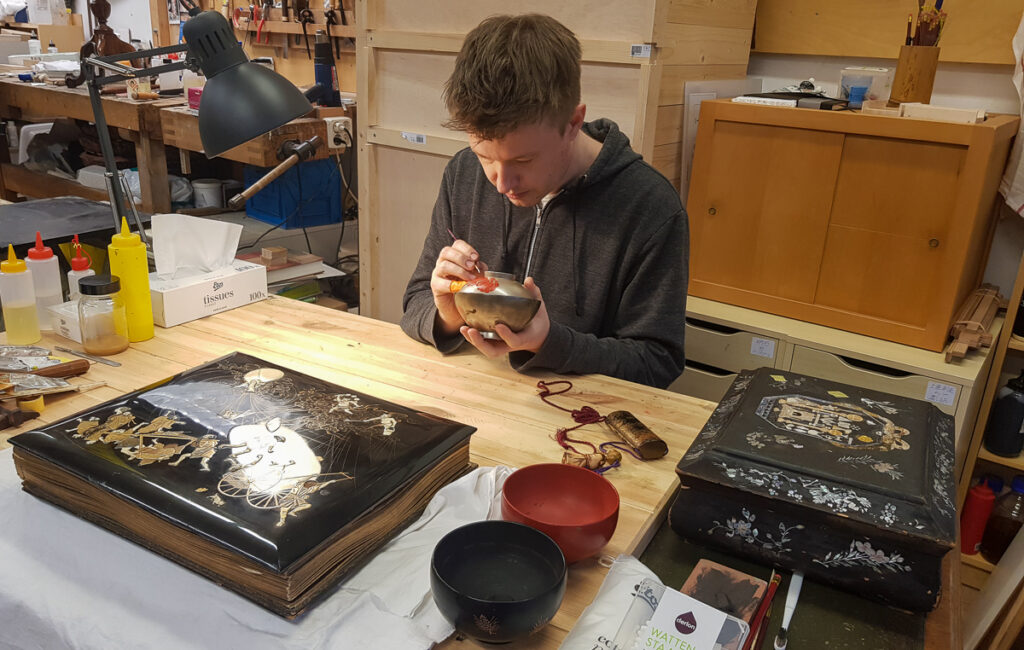
Dave van Gompel at the bench
Dave van Gompel writes about the extraordinary commitment required to master lacquer, and why it has a new-found relevance today.
(A message to the reader in English.)
(A message to the reader in Dutch.)
(A message to the reader in Japanese.)
Japanese lacquer has a long-standing reputation for being a mysterious art form. From its curious hardening properties in a sauna-like environment to the vicious skin rash it causes to its practitioners; lacquer is not for the easily discouraged. Those who had the pleasure of meeting a lacquer craftsperson will have often heard the praise of lacquer being an entirely natural material, which seems to put it on much higher standing than any synthetic resin designed to imitate its brilliant lustre. One can sense that many practitioners of urushi have developed an intimate physical and spiritual bond with the material, which almost makes them worship it like a living creature. It is a feeling that is difficult to grasp for Western observers who are unfamiliar with this exclusively Asian material.
In addition to the almost spiritual reverence of the material itself, observers of Japanese culture will notice that lacquered items still play an important role in the daily lives of the Japanese people. The interiors of temples and shrines are often coated in natural lacquer, as well as the portable mikoshi shrines which are carried through town during festivals. Lacquer is also dominant in traditional tableware, where its naturally disinfectant properties 1.The antibacterial properties of lacquer have long been suggested by Japanese chefs and lacquer artists. The first scientific evidence for such claims was published by Ogawa (2007). are a perfect fit for serving raw foodstuffs and preserving the delicate flavour of dashi stock. Even in a society dominated by plastics, most Japanese families still own a set of lacquered bowls and chopsticks to be used during special occasions, much like the role silverware used to play in western culture.
What makes urushi so different from any other tree resin or in fact plastic? While it would be overly ambitious to try and offer a full insight into the role of lacquer in the spiritual lives of the Japanese people, this article can point out some elements which may lead to a better understanding of the cultural context in which appreciation for this curious resin developed. Despite the fact that urushi arguably has many drawbacks in both use and production, this ancient tradition has—seemingly against all odds—managed to survive into modern times. Still, the use of lacquer is showing a continued decline in Japan, and its manufacture and use have nearly died out in countries like Korea and Thailand. By offering some understanding about its importance as a bearer of cultural heritage, it is my hope that urushi lacquer will receive more recognition as a unique art form that is deserving of more appreciation and support.
Connecting to the Lacquer God
The world of urushi is embedded with inherent poetry. The lacquer sap is tapped from the Toxicodendron vernicifluum species of trees, which can be found in mountainous areas of temperate Japan, Korea and China. In Japan, trees are left to grow for up to 15 years before being bled to death within a single harvesting season. Between June and September, cuts are evenly distributed along the bark to develop an instantly recognizable pattern. During its life, a single tree produces no more than a toothpaste tube worth of lacquer before succumbing to the multiple scratches in its bark.

Harvesting lacquer results in a recognisable trapezoid-shaped distribution of cuts along the bark. Picture courtesy of Dr. Tien Trieu Khac.
Much like the tree’s bark is maimed during the harvesting process, nature seeks its revenge on the skin of the lacquer craftsperson. In what seems like an act of karma, all lacquer students have to endure horrible rashes before finally growing tolerant to the highly allergenic sap (Although the body never develops full immunity to lacquer, rash eventually disappears as the immune system stops responding to exposure). Essentially a concentrated form of poison ivy,2.The allergenic compound in both poison ivy and Japanese lacquer is urushiol. Poison ivy contains lower amounts of urushiol, making it unsuitable as a source for harvesting lacquer. Typical Japanese urushi lacquer contains between 66-76% pure urushiol (Miyakoshi, p. 70 uncured lacquer causes blistering rashes which cause its sufferer almost unbearable itch and many sleepless nights. Building tolerance typically takes up to two years and has students living in constant fear of the very material they eventually hope to use on a daily basis. This begs the question: why would anybody be crazy enough to put themselves through this?
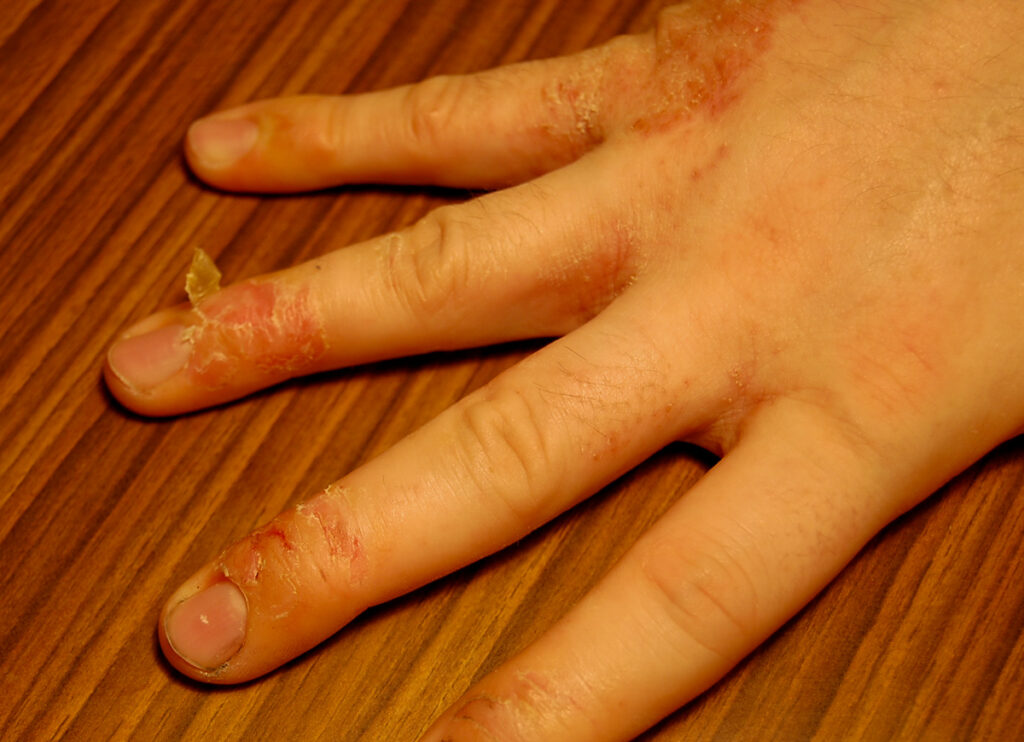
Lacquer rashes are persistently itchy and painful until practitioners finally become desensitised to the highly allergenic material. Picture by author.
From 2013 to 2018, I was trained as a lacquer artist at the Tokyo University of the Arts. From personal experience, I can attest that the period of desensitising is perceived as an initiation rite into the lacquer world. Using gloves is frowned upon, and those who suffer from a rash will receive little sympathy from teaching staff or fellow students. As I went through many sleepless nights to the point where the skin from my wrists was falling off, my teacher took me by the hand and reassuringly told me: “The Lacquer God is trying to connect with you. Stop resisting and you will be fine” (The Japanese word ‘Kami’ (神) in Shinto religion can be more accurately translated as nature spirit or holy force.).
Although those words meant little to me at the time, I later understood that lacquer is perceived as a living substance, containing a capricious spirit that resists anybody who is not yet deemed worthy. In other words: once the Lacquer God accepts your commitment, your rashes will disappear. This anthropomorphic interpretation of lacquer allergy finds its roots in Shinto practices and actually helps the troubled students to endure and overcome. Some eventually grow such resilience towards the raw sap, that they regularly ingest raw lacquer as traditional Chinese medicine. Lacquer is still regularly consumed as a medicinal ingredient in South-Korean cuisine. A famous dish is lacquer chicken soup or Ott-dakku (옻닭) It also helps in building a spiritual relationship between all practitioners of urushi art and makes the maker feel in touch with nature. Even after hardening, the Lacquer God is said to reside within the finished products, thus establishing a link between the consumer and the spirit realm. We will return to this subject when discussing tableware later on.
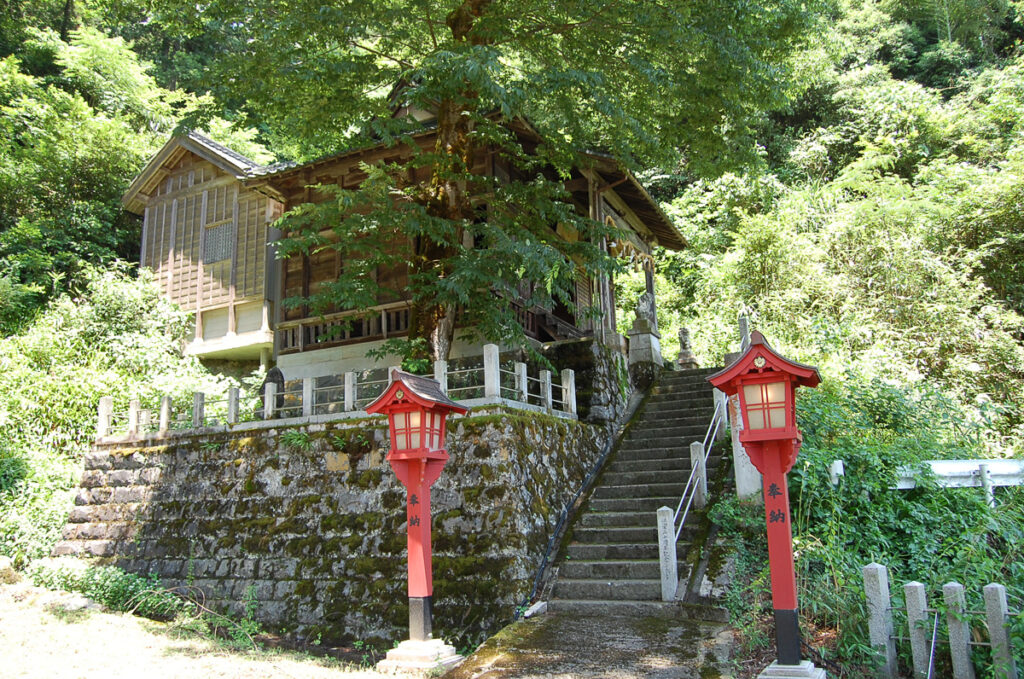
The Kawada Urushi-jinja or ‘Lacquer Shrine’ in Sabae city, Echizen region. The ceiling of the shrine is covered with decorative lacquer panels made by local craftsmen. Picture by author.
The bond between the craftsperson and the material deepens as the student develops his or her skill. In traditional training, students are taught to rely on empirical observation and direct interaction with the material, rather than recipes or prescribed methods.3.It took scientists until the early nineties to fully comprehend the chemical composition of lacquer. Surprisingly, this field of research seems almost entirely disconnected from the world of lacquer arts and crafts, because it offers practitioners little relevant information beyond what they already know. One could argue that both the scientific approach and empirical approach offer valuable insights, but only the latter will give somebody the knowledge to fully understand lacquer on the level that is required to make or restore artworks. Or as my teacher put it into words: “the material tells you what to do you just have to listen”.
In daily practice, it makes perfect sense to perceive uncured lacquer as a living creature. Urushi lacquer polymerizes through the help of an enzyme, which catalyses in the presence of oxygen and sufficiently high temperature and humidity (Ideal hardening conditions are around 24 degrees Celsius with a humidity between 65-80%). If one of the three catalysts is missing, the enzyme will eventually perish and leave the craftsperson with uncurable “dead lacquer”. The properties of every batch of lacquer are different due to natural fluctuations in lacquer’s quality, depending on factors like location, season and even growing conditions for every single tree. The student will eventually become so accustomed to perceiving the material’s behaviour and environmental conditions, that they can work entirely on instinct without using thermometers or hygrometers.
Past and present
Another way for beginning practitioners to connect to lacquer is through ancestry and the craft’s historical lineage. The Japanese use the word kakei (家系) to indicate a lineage. Though typically indicating family, the same term applies to those who are part of a lineage of artists or craftsmen. Traditional Japanese craftspersons—not exclusively to lacquer—are absorbed into a school or “house” after completing their studies under a master. The connection between master and disciple is often perceived as being stronger than kinship, which is why living artists sometimes claim to be a direct descendant from a famous Edo period master. Under the old system, a fully trained disciple would even receive a new name from his master, thus becoming part of an ever-developing lineage. The new name is typically a combination of the Chinese characters from the names of two earlier generations of masters. Considering these conditions, it is not surprising that people can be designated as living national treasures under the Japanese preservation policy. Rather than being awarded for creativity, the living national treasures are awarded for being the bearers of tradition. (The law which recognizes living persons as national heritage was first enacted in 1955, under legislation code: 文化財保護法第71条第2項)
Even though this traditional master-disciple relationship is rapidly disappearing under modern education policies, its core philosophy is still present within lacquer training. So much so, that our entire class of roughly 25 lacquer students would undergo annual trips to the graveyard to offer our respect to the founder of the university’s lacquer department. Ceremonies and parties revolving around Shinto practices and ancestral veneration further push students into a sense of belonging and force them to take responsibility in furthering Japan’s lacquer lineage.
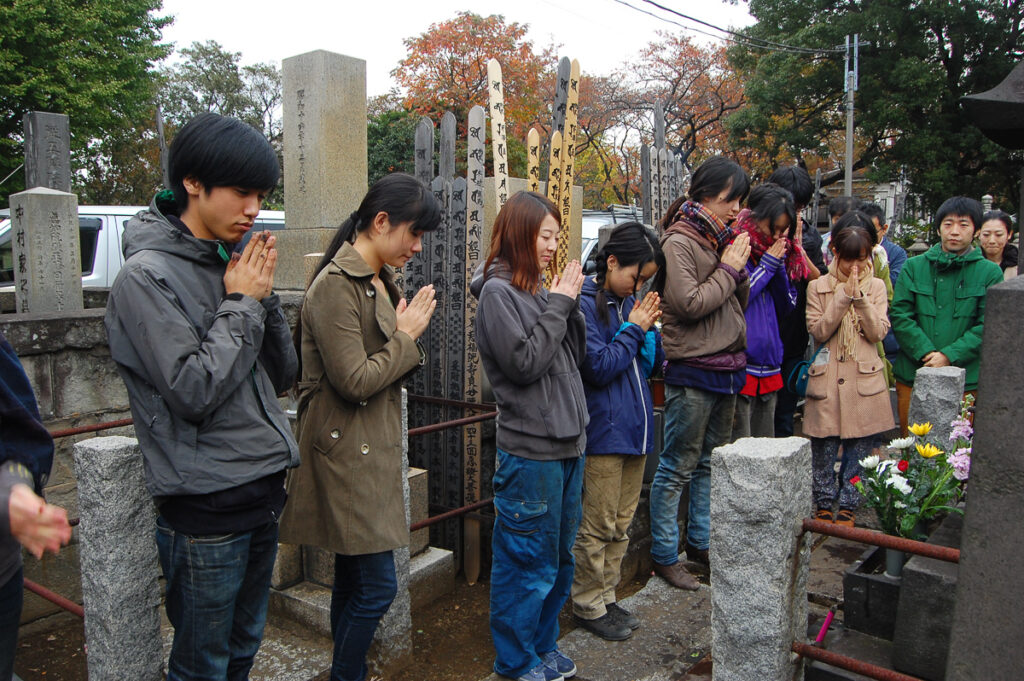
Lacquer students from the Tokyo University of the Arts pay their respects to the founder of their ‘house’ (Shoumin Ogawa, 小川松民) at Yanaka cemetery, Tokyo. Picture courtesy of Dr. Tien Trieu Khac
Religious roots
The interpretation of lacquer as a bridge to the spirit realm may find its roots as far back as Japan’s prehistoric times. Perhaps surprisingly, lacquer is one of the oldest known crafts in Asia. The oldest excavated lacquer item has been carbon-dated to a staggering 9000 years old (Yotsuyanagi, p. 9, 41). Little is known about the Jomon culture responsible for creating Japan’s oldest artworks, but excavations seem to indicate that lacquer coatings were reserved for only the most precious items in Japan’s earliest settlements (Kokubo, p. 27). It is generally assumed that the Jomon people practiced an early form of Shinto animism, making it plausible that lacquered items played an important role in votive or shamanistic rituals. Excavated items are predominantly lacquered in vermillion, which is still the main colour used in today’s Shinto shrines (Ichikawa, p. 45, 46, Kokubo, p. 24).
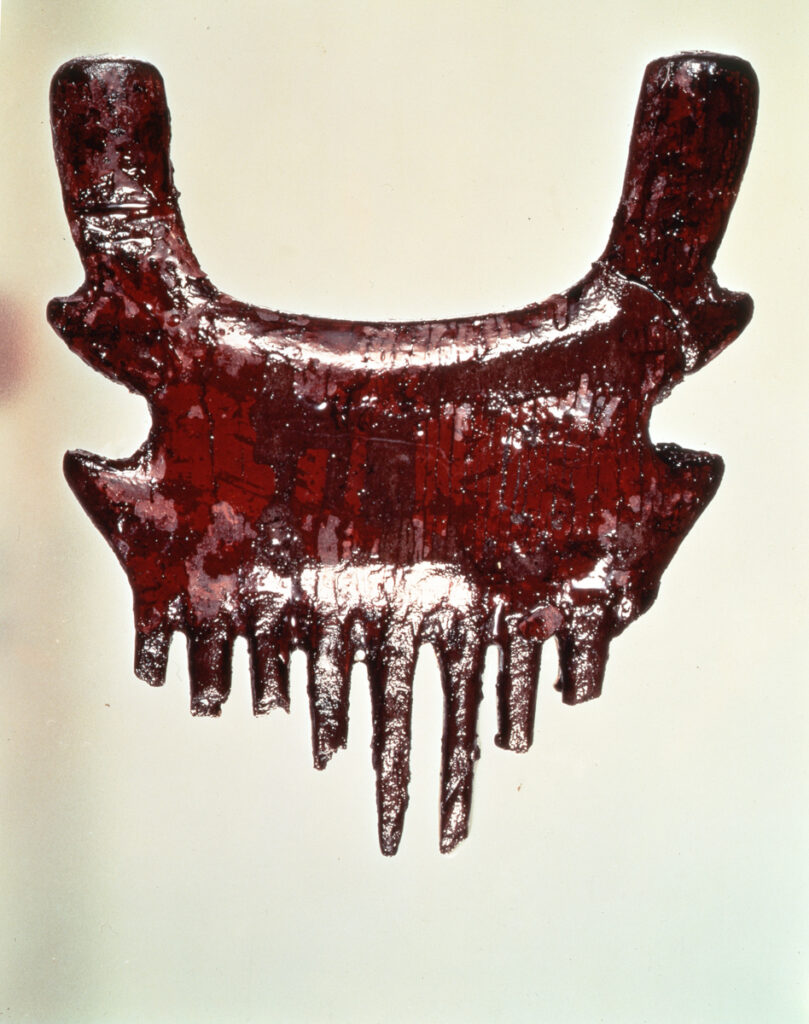
Jomon-period vermilion lacquered comb, 4000 B.C. Excavated at the Torihama Kaizuka site in Fukui prefecture. Picture courtesy of the Wakasa History Museum.
With the advance of Buddhism from mainland Asia during the Nara period (8th -9th century), Japan’s lacquer craftsmen found stable patronage under the temple clergy. Some of Japan’s oldest lacquer production centres -Wajima and Kisshu- developed from crafts communities which centred around important temples (Gonroku, p. 188. Kisshu lacquer is said to have developed under the patronage of Negoro temple (根来寺), whereas Wajima produced lacquer for Sojiji temple (總持寺) ) From simple red- and black lacquered bowls and trays, clergy patronage allowed the adaptation of new decorative techniques coming from China and Korea. Amongst many of Japan’s National Treasures preserved in Nara’s Shoshoin temple, we find a great number of imported lacquer artworks from China and Korea featuring gilding, pearl inlay, gold sheet inlay; but also the earliest example of sprinkled gold powder, called maki-e (The item in question is a scabbard known as kingindenzari no karatachi, preserved at Shosoin treasury northern storage, no. 33 (北倉 38)). These masterpieces of lacquer from the Tang dynasty had arguably encouraged the Japanese to treat lacquer as an art form and continue their refinement of both aesthetics and craftmanship.
With the cultural dominance of the imperial court in the Heian period and later the merchant class during the Edo period, lacquer culture gradually spread outside its religious cradle. As secure trade networks allowed for safe travel, many villages started to produce lacquerware for a rising middle class. Almost all surviving lacquer craft villages can have their origins traced back to the politically stable Edo period. But rather than ornate boxes and furniture reserved for Japan’s elite, these urushi no sanchi (lacquer production centres) brought affordable lacquer to the masses in the form of tableware and simple household items. Most of these villages developed around heavily wooded areas, in symbiosis with woodworkers and farmers.4.Original documents from the Edo period still remain, in which woodworkers and lacquer craftsmen ask the local Daimyo for permission to harvest the wood and lacquer, in exchange for donating part of their lacquer harvest for the maintenance of the Shogun’s lacquer collection. Turners and joiners offered solid base materials to lacquer on, whereas farmers cultivated lacquer trees in the mountains.

A typical set of lacquer bowls with simple decorations in engraved gold (chinkin), produced in Japan’s urushi no sanchi. Picture courtesy of the Echizen Lacquerware Cooperative.
Searching for the real thing
In the West, urushi lacquer is still best known in the form of highly decorative boxes in many shapes and sizes. The importance of lacquered tableware is hardly even touched upon in English literature, whereas Japanese people are mostly familiar with urushi in the form of bowls, chopsticks, and trays for daily use. Here we can return to our earlier discussion of lacquer being a bridge to the spirit realm. Many Japanese still separate items for daily use into honmono (‘the real thing’) and nisemono (fake, or imitation). Typical honmono are made from natural resources, through traditional techniques which have been cultivated for centuries. They fall under the umbrella term kougei, which is generally translated in the ultimately shortcoming English word “craft”. The word Kougei incorporates not only a sense of skill, but also long-standing tradition, technical ingenuity and living in harmony with nature and the materials nature provides us with. Also, the western connotation of “craft” being lacking in creativity when compared to the arts, is not prevalent in Japan. The honmono item carries the spirit of the craftsperson and the lacquer God, both of which are lacking in the nisemono spray-painted bowls found in Japan’s 100-yen shops. Hand-lacquered urushi bowls may be expensive, but offer the consumer much more than sheer functionality. This is perhaps an important reason why Japanese people often struggle with the translation of the word urushi into English. One could claim that urushi can be interpreted as a type of lacquer, but lacquer does not necessarily mean urushi. The word lacquer has come to be used as a generic term for a wide range of resinous coatings with high gloss. Treating urushi as any other paint, resin or plastic ignores the rich cultural context from which Asian lacquer art developed. It does not mean that Japanese urushi is technically superior to any other form of lacquer, but rather that it is unique in the way that its tradition, craftspersonship and cultural relevance have developed over the centuries without any notable interruption in production.
Although this awareness is diminishing among the younger generations, many Japanese families still treat their lacquered tableware with respect and use it during special ceremonies or events. Everybody who has visited Japan will probably be familiar with the phrase itadakimasu at the beginning of every meal. Although not quite the same as saying grace, the Japanese do take a moment to thank nature for the gift of nourishment and establish a direct link between themselves and the spirit realm through the consumption of food. Or in a theory posed by Mitamura: the word for ‘chopsticks’ has the same pronunciation as the word “bridge” in Japanese because both establish a meaningful connection between one realm and another (Mitamura, p. 129-131). During an intimate moment like the consumption of a meal in the company of family, the use of honmono strengthens the bond between consumer, maker and the Shinto spirits. In addition to its natural beauty, urushi lacquer forms the perfect channel through which these thoughts and feelings can be transmitted.

Celebration of the 100th day after birth when the baby starts eating solid food. The couple feeds their baby for the first time using a pair of lacquered chopsticks. Picture courtesy of the Mitamura family
Being fully aware that this article does little justice to the rich cultural history of lacquer art, I do hope that these short reflections offer some insight into what makes urushi so special to the Japanese people and why it deserves more appreciation. Many of Japan’s lacquer craft centres are struggling to survive and urushi artists can’t support a family from their works. When buying a handmade piece of lacquer, it is important to realize that thousands of years of tradition are embedded in the item, as well as a spiritual philosophy which enriches the item with additional value. Perhaps this feeling is best captured by Tanizaki in Japan’s most famous treaty on aesthetics In praise of Shadows: ‘It has been said of Japanese food that it is a cuisine to be looked at rather than eaten. I would go further and say that it is to be meditated upon, a kind of silent music evoked by the combination of lacquerware and the light of a candle flickering in the dark.’ (Tanazaki, chapter ‘Candlelight and lacquerware’)
References
Ichikawa, Takeo (市川健夫). ‘Use of Lacquer in the Jomon Period’ in 北の縄文Ⅰ―漆―. International Jomon Culture Conference proceedings, p. 32-60.
Kokubo, Takuya (小久保拓也). ‘Lacquer in the Jomon Period’ in 北の縄文Ⅰ―漆―. International Jomon Culture Conference proceedings, p. 8-32.
Matsuda, Gonroku (松田権六) うるしの話. Iwanami Shoten publishers (2001 ed.)
Mitamura, Arisumi (三田村有純) 藝術がいづる国・日本. Tokyo University of the Arts Publishing (2017)
Ogawa, Toshio (小川俊夫). 漆膜および関連材料の抗菌性. Journal of the adhesive society of Japan: vol. 43, no. 6 (2007), p. 225-229.
Miyakoshi, Tetsuo (宮腰哲雄). 漆学. Meiji University Liberty Books (2016)
Tanizaki, Junichiro. In praise of shadows (陰翳礼讃), Gregory Starr transl. Sora Books (2017)
Yotsuyanagi, Hiroaki (四栁嘉章). 漆・悠久の系譜 . Ishikawa prefectural Wajima Museum of Urushi Art (2011)
Author

Dave van Gompel was born and raised in Amsterdam, where he was initially trained as a furniture conservator and art historian. From 2013 to 2018, Dave spent 5 years at the Tokyo University of the Arts to obtain a PhD-degree in urushi art (Japanese lacquer). Japan has had a huge impact on the way Dave perceives crafts, cultural heritage and art education. For his main job, he runs a lacquer conservation studio called Koumou Urushi in Amsterdam, where he mostly restores Edo-period antiques. Dave also does research at the University of Amsterdam in the field of lacquer art and skills transfer, with a strong focus on East-Asia.
References
| ↑1 | The antibacterial properties of lacquer have long been suggested by Japanese chefs and lacquer artists. The first scientific evidence for such claims was published by Ogawa (2007). |
|---|---|
| ↑2 | The allergenic compound in both poison ivy and Japanese lacquer is urushiol. Poison ivy contains lower amounts of urushiol, making it unsuitable as a source for harvesting lacquer. Typical Japanese urushi lacquer contains between 66-76% pure urushiol (Miyakoshi, p. 70 |
| ↑3 | It took scientists until the early nineties to fully comprehend the chemical composition of lacquer. Surprisingly, this field of research seems almost entirely disconnected from the world of lacquer arts and crafts, because it offers practitioners little relevant information beyond what they already know. One could argue that both the scientific approach and empirical approach offer valuable insights, but only the latter will give somebody the knowledge to fully understand lacquer on the level that is required to make or restore artworks. |
| ↑4 | Original documents from the Edo period still remain, in which woodworkers and lacquer craftsmen ask the local Daimyo for permission to harvest the wood and lacquer, in exchange for donating part of their lacquer harvest for the maintenance of the Shogun’s lacquer collection. |


Comments
I am amazed at the labor that goes into each piece . I have 3 pieces of lacquer ware . Very rare , and it was my spirit that brought me to the works of art. I had no intentions of buying anything. But when I saw these pieces I did not think twice. I am an artist of sorts . I would like to share my worldly pieces with others who have a connection with this labor of love to nature .
I’m so happy to have found this wonderful history of lacquerware. I’ve become obsessed with the art of Kintsugi and am currently suffering from the urushi rash- on my forearms and my face. Luckily (so far), it’s not itchy and I am able to sleep just fine. I will thank the lacquer god from here on and not complain about the side effect of doing something I’ve come to love.